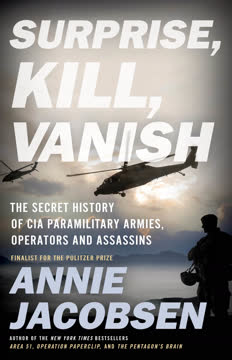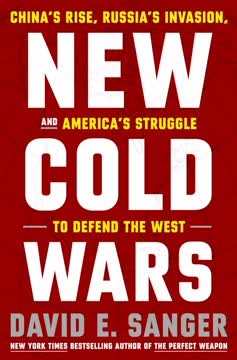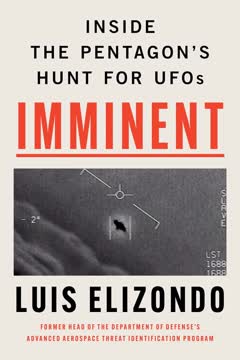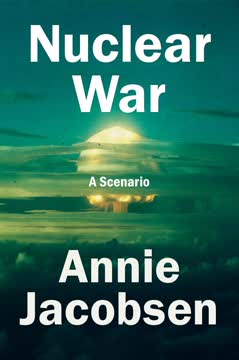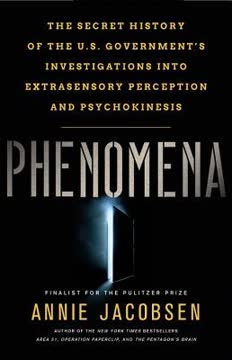Key Takeaways
1. Covert Action: The President's Third Option
Some might say this is a book about assassination, but really it is a book about covert action, Tertia Optio, the president’s third option when the first option, diplomacy, is inadequate and the second, war, is a terrible idea.
Beyond Diplomacy and War. Covert action emerged as a middle ground, a tool for presidents to exert influence without resorting to open conflict or ineffective negotiations. This "third option" allows for deniability and flexibility in addressing national security threats.
Hidden Hand Operations. These actions are classified and designed to be plausibly denied, making them the president's "hidden hand." This secrecy allows for operations that might be politically or diplomatically sensitive if publicly acknowledged. The most extreme form of covert action involves targeted killings.
Legal Framework. While assassination is illegal, killing a leader or prominent person at the behest of the president is legal under Title 50 of the U.S. Code. This legal distinction allows for the elimination of threats to U.S. national security while maintaining a degree of separation and deniability.
2. The Birth of the CIA's Guerrilla Warfare Corps
With its ethos in unconventional warfare, the Central Intelligence Agency officers and operators who conduct covert action were originally called the president’s guerrilla warfare corps.
Post-WWII Origins. The need to avert World War III led to the creation of a specialized unit within the CIA, designed to conduct unconventional warfare. This "guerrilla warfare corps" was intended to counter Soviet influence and expansionism.
Modeled After SOE. The CIA's covert action arm drew inspiration from the British Special Operations Executive (SOE), known as Churchill's "Ministry of Ungentlemanly Warfare." This influence shaped the CIA's approach to sabotage, subversion, and other unconventional tactics.
Surprise, Kill, Vanish. The motto of the OSS Jedburghs, "Surprise, Kill, Vanish," encapsulates the ethos of these early covert operations. The focus was on disrupting enemy operations, creating paranoia, and weakening their hold on power through targeted actions.
3. The Murky Morality of Targeted Killing
The idea that most people find hand-to-hand killing repugnant but mechanized killing somehow more palatable is central to this book.
Moral Ambiguity. The book explores the moral complexities of targeted killing, questioning why some forms of killing are considered more acceptable than others. This raises questions about the ethics of covert action and the justifications for taking a human life.
Evolving Terminology. Over time, the language used to describe targeted killing has shifted, from "eliminating" and "neutralizing" to "lethal direct action" and "targeted killing." These changes reflect an ongoing effort to grapple with the moral and legal implications of these operations.
Legal Justification. Killing a leader or prominent person is legal under Title 50 of the U.S. Code, but the question remains: how does killing any one person advance U.S. foreign policy objectives? The book aims to shed light on the rationale behind these decisions.
4. Korea: A Testing Ground for Unconventional Warfare
Korea became a testing ground for the support of conventional warfare with unconventional efforts, or black operations behind enemy lines.
Early Failures. The CIA's initial efforts in Korea were marked by intelligence failures and disastrous operations. The agency struggled to identify reliable local forces and faced challenges in operating behind enemy lines.
Rise of Special Forces. The Korean War highlighted the need for a dedicated special operations capability within the U.S. military. This led to the creation of the 10th Special Forces Group, an unconventional warfare unit designed to operate behind enemy lines.
Invention of HALO. The Korean War also saw the development of high-altitude, low-opening (HALO) parachute drops, a technique pioneered by Jack Singlaub. This method allowed for more clandestine insertion of covert action operators into denied territory.
5. The Perils of Regime Change: Guatemala and Beyond
To understand and embrace OSS-style guerrilla warfare was to reject preconceived notions of honor, chivalry, and fair play as the gentleman’s way of war.
Operation Success. The CIA's covert operation to overthrow Guatemalan President Jacobo Arbenz served as a model for future interventions. However, it also had unintended consequences, including the rise of Che Guevara.
Assassination Lists. The CIA compiled lists of individuals to be "disposed of" during the coup, highlighting the agency's willingness to engage in targeted killing. This operation set a precedent for future regime change efforts.
Unintended Consequences. The intervention in Guatemala led to decades of violence and instability, demonstrating the potential for covert action to backfire. The rise of Che Guevara, who was radicalized by the coup, is a prime example of these unintended consequences.
6. The Escalating Cold War: Assassination and Proxy Wars
Cold War concerns convinced President Eisenhower to order the removal of the democratically elected leader by force.
Iran and the Shah. The CIA's involvement in the 1953 Iranian coup, which overthrew Prime Minister Mohammad Mossadegh and strengthened the Shah's rule, demonstrated the agency's willingness to intervene in foreign governments to protect U.S. interests. This action had long-term consequences for U.S.-Iranian relations.
The KGB's "Liquid Affairs." The defection of KGB assassin Nikolai Khokhlov revealed the Soviet Union's use of assassination as a tool of foreign policy. This revelation heightened Cold War tensions and fueled the U.S. government's own covert operations.
The Special Group. President Eisenhower's advisors openly discussed plans to assassinate foreign leaders, highlighting the increasing acceptance of targeted killing as a legitimate tool of statecraft. This group formalized the process of selecting and approving assassination targets.
7. The Green Berets: Masters of Unconventional Warfare
What I want you to do is get the dirtiest, bloodiest, ideas in your head that you can think of for destroying a human being.
Birth of Special Forces. The U.S. Army Special Forces were created to conduct unconventional warfare behind enemy lines, training and equipping guerrilla fighters to resist communist expansion. This marked a shift in U.S. military doctrine, embracing tactics previously considered "ungentlemanly."
Larry Thorne: The Quintessential Green Beret. The story of Larry Thorne, a Finnish soldier who fought for three different armies, exemplifies the unique skills and mindset of Special Forces operators. His expertise in irregular warfare made him an invaluable asset to the U.S. military.
Training Foreign Armies. Special Forces teams were deployed around the world to train and equip foreign armies, building alliances and preparing for potential conflicts. This effort aimed to contain Soviet influence and promote U.S. interests.
8. The Secret World of MACV-SOG
The mission of these Jedburgh teams was to blow up infrastructure, kill Nazis, and disappear without a trace. In this way the official motto of the Jedburghs became “Surprise, Kill, Vanish.”
Top Secret Operations. MACV-SOG (Military Assistance Command, Vietnam – Studies and Observations Group) was a highly classified unit that conducted covert operations behind enemy lines in Vietnam, Laos, and Cambodia. These missions were designed to disrupt enemy supply lines, gather intelligence, and conduct sabotage.
Cross-Border Missions. SOG operators often crossed into neutral countries like Laos and Cambodia, violating international law in pursuit of U.S. objectives. These operations were kept secret to maintain plausible deniability.
High-Risk, High-Reward. SOG missions were incredibly dangerous, with a high casualty rate. The unit attracted some of the most skilled and daring soldiers in the U.S. military, who were willing to take extreme risks to achieve their objectives.
9. The Secret Service: Guardians Against Assassination
The fighting I’m going to show you is not a sport. It’s every time, and always, fight to the death.
Deterrence and Protection. The U.S. Secret Service plays a crucial role in deterring assassination attempts against the president. The agency's Counter Assault Team (CAT) is a highly trained paramilitary force designed to respond to any threat with overwhelming force.
Lessons from Vietnam. The experiences of Secret Service agents who served in Vietnam as Green Berets shaped their approach to presidential protection. These agents brought a unique understanding of unconventional warfare and the importance of anticipating threats.
Constant Vigilance. The Secret Service is constantly adapting its tactics and strategies to counter evolving threats. The agency's focus on speed, surprise, and violence of action reflects the need to be prepared for any eventuality.
10. The Enduring Legacy of Covert Action
I am tired and sick of war. Its glory is all moonshine. It is only those who have neither fired a shot nor heard the shrieks and groans of the wounded who cry aloud for blood, for vengeance, for desolation. War is hell.
A Cycle of Violence. The book highlights the cyclical nature of violence, with each act of covert action often leading to retaliation and escalation. This raises questions about the long-term effectiveness and consequences of these operations.
The Moral Twilight Zone. Covert action often operates in a "moral twilight zone," where the lines between right and wrong become blurred. This can lead to ethical dilemmas and unintended consequences for those involved.
The President's Burden. Ultimately, the decision to authorize covert action rests with the president. This responsibility weighs heavily on the commander in chief, who must balance national security interests with moral considerations.
Last updated:
FAQ
1. What is Surprise, Kill, Vanish by Annie Jacobsen about?
- Secret history of CIA paramilitary operations: The book uncovers the evolution of CIA paramilitary armies, operators, and assassins from World War II through the post-9/11 era, focusing on covert action as a “third option” in U.S. foreign policy.
- Covert action and assassination: It details how the CIA institutionalized sabotage, guerrilla warfare, and targeted killings, often under legal and euphemistic frameworks, to influence global events.
- Human stories and moral dilemmas: Through interviews and declassified documents, Jacobsen explores the personal experiences, psychological toll, and ethical ambiguities faced by those involved in clandestine warfare.
2. Why should I read Surprise, Kill, Vanish by Annie Jacobsen?
- Unprecedented insider access: Jacobsen interviewed dozens of CIA operatives, OSS veterans, and intelligence officers, providing rare firsthand insights into secret operations.
- Comprehensive historical scope: The book covers major covert actions from WWII to the War on Terror, revealing how these shaped U.S. foreign policy and modern warfare.
- Exploration of moral and legal complexities: Readers gain a nuanced understanding of the ethical, legal, and psychological challenges inherent in covert action and assassination.
3. What are the key takeaways from Surprise, Kill, Vanish by Annie Jacobsen?
- Covert action as a “third option”: The CIA’s paramilitary operations serve as a hidden hand for U.S. presidents when diplomacy and open warfare are inadequate.
- Evolution of assassination policy: The book traces how assassination shifted from taboo to a regulated, yet secretive, tool authorized by presidential findings.
- Unintended consequences and complexity: Covert operations often produce unforeseen outcomes, such as regional instability or empowering radical groups, highlighting the risks of clandestine warfare.
4. What is the concept of “Tertia Optio” in Surprise, Kill, Vanish by Annie Jacobsen?
- Definition and origin: “Tertia Optio” (Latin for “third option”) refers to covert action as the president’s alternative when diplomacy fails and war is undesirable.
- Legal and organizational framework: Established post-WWII, it gave the CIA authority to conduct covert paramilitary operations under Title 50 of the U.S. Code, with oversight from the National Security Council.
- Strategic importance: Tertia Optio enabled the U.S. to counter Soviet covert activities and act secretly, forming the basis for the president’s “hidden hand” in foreign policy.
5. How did the OSS and British SOE influence CIA paramilitary operations according to Annie Jacobsen?
- Foundational legacy: The CIA’s Special Activities Division and Ground Branch trace their roots to the OSS and British SOE, both of which specialized in guerrilla warfare, sabotage, and assassination during WWII.
- Training and tactics: OSS Jedburgh teams and SOE commandos were trained in unconventional warfare, operating behind enemy lines and rejecting traditional “gentlemanly” combat.
- Postwar evolution: Many OSS veterans joined the CIA, shaping its paramilitary capabilities and influencing Cold War covert operations worldwide.
6. How does Surprise, Kill, Vanish by Annie Jacobsen describe the evolution of assassination as a covert-action tool?
- Legal and euphemistic framing: Assassination, though illegal under international law, was conducted under euphemisms like “Executive Action” or “neutralization,” with legal cover from presidential findings.
- Operational details: The CIA developed manuals and training for assassins, emphasizing stealth, psychological readiness, and plausible deniability.
- Moral and psychological toll: The book highlights the ethical dilemmas and psychological burdens faced by operatives tasked with covert killing.
7. What was the Phoenix Program and its significance in Surprise, Kill, Vanish by Annie Jacobsen?
- CIA pacification effort: The Phoenix Program was an intelligence-driven initiative during the Vietnam War aimed at dismantling the Vietcong infrastructure through interrogation and neutralization.
- Controversial tactics: The program was accused of using torture, murder, and assassination, setting a precedent for later targeted killing operations.
- Legacy and influence: Phoenix influenced future CIA and military counterterrorism efforts, demonstrating the challenges and controversies of intelligence-driven warfare.
8. What is the “moral twilight zone” concept in Surprise, Kill, Vanish by Annie Jacobsen?
- Ethical ambiguity: The “moral twilight zone” describes the ambiguous ethical environment in which CIA paramilitary operators and their indigenous partners operate.
- Real-world examples: The book details issues like betrayal, human rights abuses, and cultural clashes, especially in Afghanistan, where local forces often engaged in criminal behavior.
- Operational dilemmas: Operators faced difficult choices regarding suspected double agents and criminal acts, highlighting the tension between mission success and moral accountability.
9. How did the CIA and Mossad respond to Black September and related terrorist threats in Surprise, Kill, Vanish by Annie Jacobsen?
- Black September’s threat: The group, founded by Yasser Arafat, conducted high-profile terrorist attacks, including the Munich Olympics massacre.
- Mossad’s targeted assassinations: Mossad launched Operation Wrath of God, a campaign of targeted killings against Black September operatives, including Ali Hassan Salameh.
- CIA’s complex involvement: The CIA used Salameh as a clandestine asset, balancing intelligence gathering with moral ambiguity, until his assassination by Mossad shifted the landscape of Middle East covert operations.
10. How did the CIA’s paramilitary operations shape the wars in Afghanistan and Iraq according to Annie Jacobsen?
- Afghanistan covert war: After 9/11, the CIA’s Special Activities Division led the initial invasion, working with local warlords and integrating intelligence for targeting.
- Operational challenges: Teams faced dangers such as friendly fire, shifting allegiances, and unreliable local partners, setting the stage for ongoing counterterrorism.
- Iraq covert preparation: The CIA trained Iraqi paramilitary forces for sabotage and assassination missions ahead of the 2003 invasion, aiming to destabilize Saddam Hussein’s regime.
11. Who is Billy Waugh and what role does he play in Surprise, Kill, Vanish by Annie Jacobsen?
- Veteran CIA operative: Billy Waugh is a central figure, with a six-decade career in the CIA’s Special Activities Division and Ground Branch, operating in 64 countries.
- Pioneer of covert missions: He participated in dangerous missions, including hunting terrorists, training indigenous forces, and conducting paramilitary operations from Vietnam to the War on Terror.
- Embodiment of the “hidden hand”: Waugh’s story illustrates the personal sacrifices, moral dilemmas, and operational challenges faced by CIA operators.
12. How does Surprise, Kill, Vanish by Annie Jacobsen explain the legal and ethical framework surrounding CIA assassinations?
- Presidential Findings and MONs: Covert assassinations require a Presidential Finding or Memorandum of Notification, which authorizes lethal direct action and is shared with congressional intelligence committees.
- Executive orders and international law: Executive Order 12333 prohibits assassination of political leaders but allows targeted killing of terrorists as acts of war, with administrations interpreting these rules to justify covert killings.
- Plausible deniability and secrecy: Operations are conducted with plausible deniability to protect U.S. government involvement, highlighting the tension between legal frameworks, moral considerations, and operational secrecy.
Review Summary
Surprise, Kill, Vanish receives mostly positive reviews for its engaging narrative on CIA paramilitary operations and assassinations. Readers appreciate Jacobsen's research, interviews, and focus on key figures like Billy Waugh. Some criticize the book's pro-CIA bias and factual errors. Many find it enlightening about covert operations and morally complex. The book is praised for its readability and historical context, though some note it lacks depth on certain topics. Overall, it's considered a captivating, if sometimes controversial, exploration of CIA activities.
Similar Books
Download PDF
Download EPUB
.epub digital book format is ideal for reading ebooks on phones, tablets, and e-readers.
